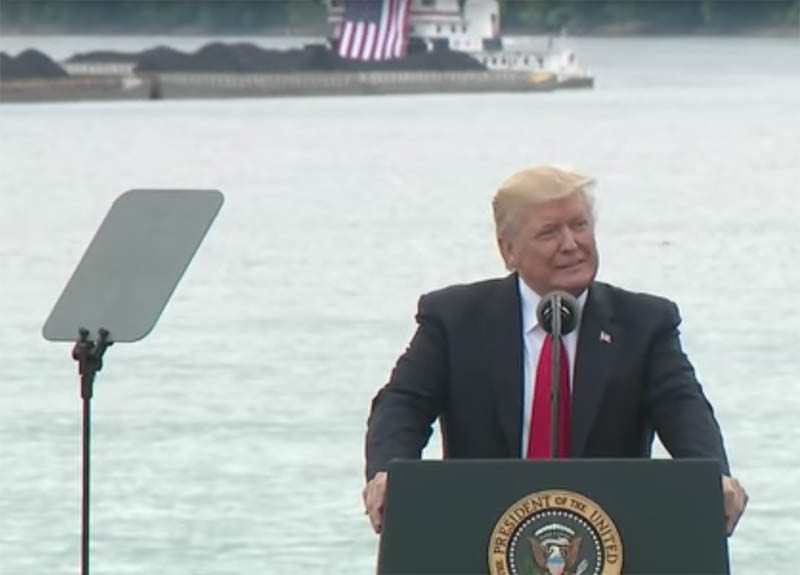President Trump unveiled his long-awaited infrastructure plan on Monday, but it was a big disappointment to users of the nation’s inland waterways, many of whom were strong supporters of the president’s election because he promised major improvements to the country’s crumbling lock and dam infrastructure.
But instead of creating a deeper federal commitment to waterways investments, the Trump plan goes in the opposite direction, upending the historic federal responsibility to fund waterways construction and management by suggesting that improvements be financed more by states, local governments, the private sector and users of the river system.
The Waterways Council Inc., an industry-supported advocacy group for waterways funding, called both the plan and the president’s fiscal 2019 federal budget, also released Monday, a “disappointment” considering the president’s promises made last June when he visited the Ohio River and spoke about the need to modernize the “dilapidated system of locks and dams that are more than half a century old.” Trump was the first president to give waterways such a high-profile billing, vowing: “Together, we will fix it.”
But the proposed fix is not what the industry had hoped for.
“The administration infrastructure proposal actually seems to mean that commercial operators and shippers are the only ones who will be expected to pay, and significantly more, for the nation’s waterways transportation system, despite being just one beneficiary of the lock and dam system,” Mike Toohey, WCI’s president and CEO, said in a statement.
Overall, the president’s initiative is more modest than the sweeping infrastructure renewal that he had envisioned as a candidate and promised in recent speeches, most recently his January State of the Union address.

Rep. Charles Fleischmann, R-Tenn., with Corps of Engineers officials inspecting the main chamber of the Chickamauga Lock on the Tennessee River. Corps of Engineers photo.
As part of his proposed $4.4 trillion federal budget for fiscal 2019, the president is asking Congress to authorize $200 billion over a decade for infrastructure improvements, with the expectation that the private sector and states would kick in another $1.35 billion in investments. The initiative makes good on an election promise, but could end up forcing people and industries to pay higher taxes, fees and tolls, according to many observers.
For waterways, the president envisions higher taxes and fees paid by inland commercial users. According to a White House fact sheet, the plan aims to “reform the laws governing the Inland Waterways Trust Fund (IWTF), including by establishing a fee to increase the amount paid by commercial navigation users of inland waterways.”
This would mean that barge operators would continue to pay the existing 29 cents a gallon diesel fuel tax — which was recently increased 45% — as well as a new waterways user fee. The budget authorizes Uncle Sam and “third party service providers” to impose and retain tolls or lockage fees on the lock and dam system.
Since 1986, the industry and federal government have evenly split the costs 50/50 of new construction through the IWTF. The Trump budget plan says that additional revenue from a new user fee “will finance future capital investments in these waterways to support economic growth.”
Waterways user fees have been proposed in the past but have been consistently rejected by Congress under heavy criticism from commercial operators, who argue that there are other beneficiaries of the waterways - commercial boaters and fishermen, hydropower plants, municipal and industrial water supplies, flood control - that don’t pay to use the system. The industry says it pays the highest tax of any surface transportation mode in the country.
If adopted, WCI estimates that the IWTF would be responsible for operating and maintaining the inland navigation system at an estimated cost that is eight times that of the current fund’s income.
“Carriers, and therefore shippers like American family farmers, energy/petroleum and coal producers, cement and construction material companies, and many others who rely on cost-competitive waterways to ship their products around the U.S. and the world, would be saddled with massive increases that deter freight from the waterways and cause a modal transportation shift,” Toohey said.
While many questions remain about funding investments, the Soy Transportation Coalition, whose members rely heavily on inland waterways to move their products, praised the president’s intention to streamline and make the process of infrastructure modernization less bureaucratic.
“Not all of our transportation challenges will be solved by the government writing a bigger check,” said Mike Steenhoek, executive director, said in a statement. “We also need more efficient processes for funding and delivering transportation projects.”
Administration officials say that the proposal is a starting point for negotiations with Congress, and as such, a final version that will eventually emerge from Congress is likely to be quite different.
Meanwhile, Trump’s fiscal 2019 budget request for the U.S. Army Corps of Engineers Civil Works program would be shaved 22% to $4.78 billion from the $6.16 billion that has been approved in 2018 by the Senate Appropriations Committee, WCI said. The request would not totally fund the IWTF, which would jeopardize three important navigation projects now under construction in Kentucky, Pennsylvania and Tennessee.
Congress will ultimately decide on the final budget numbers, and it has in the past given the Corps healthy increases.




